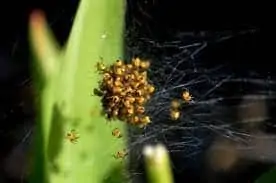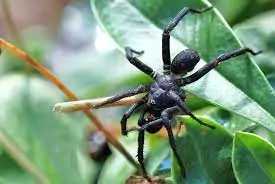If you are asking questions such as Do houseplants attract spiders? Then you are at the right place. An infestation of any kind can ruin the plant forever.
The best way to deal with these problems is by making sure to eradicate these problems before the bugs start reproducing at a higher rate. This tends to be the case for most bugs that get attracted to plants.
Do House Plant Attract Spiders? I get asked quite often, do house plants attract spiders and my answer is, Yes, house plants do attract spiders, they also attract aphids, fungus gnats, spider mites, whiteflies, and mealybugs, these are some of the most common ones. There are others as well.
If you are worried about your plant attracting bugs, then this article will give you all the information you need to know about bug infections on plants and how can you deal with them, so it won’t happen ever again.
The environment outside is far harsher than whatever goes on inside, so the indoor plants tend to suffer less compared to the plants that are outside.
The problem takes the same pace as the plants that stay outside. They will catch the attention of different bugs and harsher weather. Indoor plants tend to experience less of that, this is the reason why people who want to get into the gardening hobby tend to go after indoor plants.
So they have to deal with less mess compared to the lifestyle of outside plants.
Table of Contents
Do Houseplants Attract Spiders?
Spider mites can be very hard to detect due to the size of the bugs. But you will be able to find webbing between the foliage of the plants. The initial sign of spider mites infestation is the fine webbing that they produce.
You will have to inspect the plants closely to detect any of them. If not checked at the right time, they will reproduce at a large rate and will soon take over the plant. If a plant gets spider-infested, then you will see changes in the appearance of the plant.

If you have spider mites in your plant, there are processes you can follow to remove the spider mites from your plant.
You can treat the plant by rubbing alcohol or start using dishwashing soap to clean the plant or using a Botanical Pyrethrin to kill the spider mites.
The best time to deal with spider mites is when you see the infection for the first time. If you delay any further, then you will soon see the spider mites get out of proportion.
When you leave them alone with your plant, you will see the life of the plant get sucked out of it. Both the indoor and outdoor plants will suffer from spider infestation
Best Way to Deal with Spiders on Plants
If you water the plants properly, inspect them regularly on a regular basis, then you will have less mess to deal with, this will also keep the infestation of the plants at bay.
Regular inspection will keep your plants healthier and minimize the damage that could have been done to your plants. Every type of bug shares a different infection method, but the goal is always to harm your plant.
The usual sign for spider infestation is the stippled, yellow, weak leaves that you are going to see all over the plant.
Webs are the usual sign that you have a spider infestation in your hand. There are a lot of things you can do to make sure your plant stays safe from outdoor insects.
Why are Houseplants Attractive to Spiders and Other Bugs?
One of the frequently asked questions on the internet is do indoor plants attract spiders or other bugs? The answer is yes, indoor plants grab the attention of bugs.
Normally the plants that can be found indoors have warm growing conditions and high humidity. This lures pests such as spider mites, fungus gnats, scale, thrips, and the whitefly.
The only way to make sure that these bugs don’t catch the attention of your plant is by regularly checking on their conditions.
The growing conditions of the house plant differ a lot from the condition of the outside plants. Indoor growing conditions, the humidity, and the wet conditions of a home play a bigger role in attracting pests into your house.
Many bugs are humidity sensing. If they sense a place that has high humidity, then they will automatically be drawn towards that area. Pests need to keep their body moist, so they are looking for areas where the moisture level is higher than usual.
If they ever let their body dry up, then they will die immediately, that is why they seek out areas where they can use the humidity in the environment to their advantage.
Air Functionality in Houseplants
Air movement also plays a role in bug activity. When the humidity level goes up, it will attract new bugs into your room. When you increase the ventilation of your room, it will dry out the soil, which will decrease the fungal growth and infection of your plants.
Air centralization ventilation will have a direct effect on the bugs you have in your home. This is how airflow will play a role in stopping the infestation from growing at a larger rate in your plants.
Another way to stop the infestation is by checking the placement of plants in your house. When you put your plants close to each other, this will decrease the air ventilation of the foliage.
While it is good to place plants close to each other to increase humidity in the air, so they can moisturize. But leaving them for a longer time will limit the air circulation this will get the bugs infecting more plants if they ever get their hands on one.
You should always place your plants in a ventilated area, air movement is necessary for the plants to grow healthier without attracting anything else.
Conclusion
While bug infestation is something that you don’t ever want to hear in your life. The possibility of this happening is very likely if you don’t check your plants properly on a daily basis.
There are ways you can prevent the bugs from infesting your plants, but if one of them manages to slip by. You can follow the steps above to get rid of the bugs in your plants.
The most crucial thing about removing bugs from your plan is the timing, make sure to take the steps before things take a turn for the worse.
Recent Posts
Have you found yourself wondering, 'why is my bamboo growing so slow?' Despite the fact that bamboo plants are remarkably fast-growing, it can sometimes take months (or even years!) to see any signs...
Miracle-Gro is a huge help when you are trying to get decent yields out of your plants or if you want them to thrive. However, you may have noticed that a single dose of fertilizer does little to...

